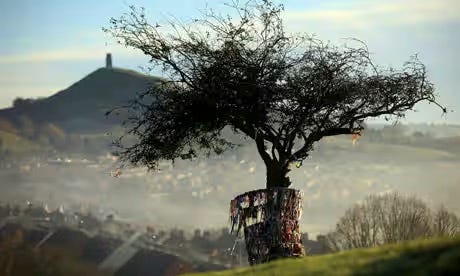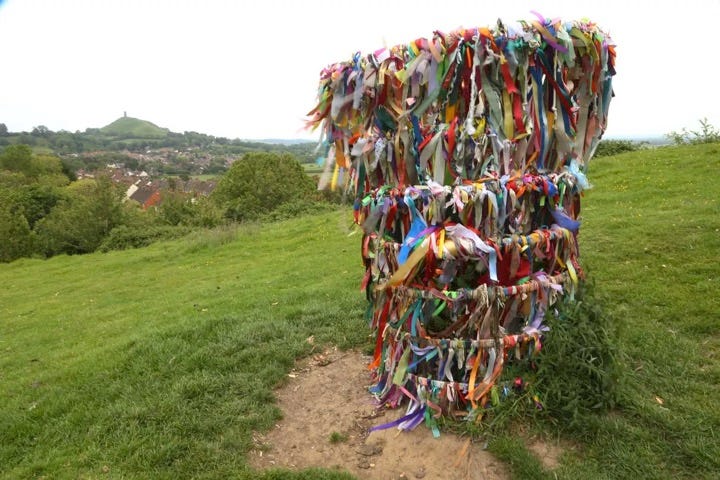Hey Epic Human,
In the midst of running various errands we popped back into Glastonbury and tied up a few loose ends.
For one thing, I’ve been wanting to see the legendary oak trees Gog and Magog for a while now, so we contrived to make that happen.
Gog and Magog are the final two trees remaining from the “Oaks of Avalon,” said to be a traditional point of entry onto this mystical island. They originally comprised a ceremonial Druidic avenue of oak trees leading towards the Tor and beyond. It was said Joseph of Arimathea followed this row of trees to the Tor upon his arrival in this legendary place. That avenue was cut down around 1906 to clear the ground of a farm. It is claimed that one of the oaks was 11 feet in diameter with more than 2,000 season rings, so making a visit to these ancient trees is truly making a pilgrimage into the past.
These two remaining oaks stand in a relationship of alignment with other aspects of the sacred landscape, such as the Tor (nearby), Chalice Hill, Glastonbury Abbey, and Wearyall Hill. These two trees gained their names from a legendary race of apocalyptic giants mentioned in the Bible and the Quran, and who—save for Gog and Magog—were slaughtered by Brutus and his Trojan army. Gog and Magog’s fates were to be marched to London where they were held, chained to the city’s palace. They are now immortalized as effigies in London’s Guildhall, where they stand as two large wooden carvings.
Sadly, the tree Gog is now dead but his remains are still here in Glastonbury, although they were badly damaged in April of 2017 when Gog was set alight from a lit candle or incense stick that was thoughtlessly left within the tree.
Firefighters tackled the spectacular blaze and managed to save the remains of Gog and made sure the flames did not spread to his twin: Magog. (Magog, sadly, is also close to the end of her life.)
I’m pretty confident this shiny new fence now enclosing Gog and Magog was erected in reaction to the fire, although Robin was able to reach up and touch Magog in spite of it. (He’s always connecting with trees through touch, so this was a special moment for him.)
From there we went into the center of Glastonbury to explore the Church of St John the Baptist, which was closed the last time we were there. This time the churchyard was open, but the church itself remained closed, so we settled for a few selfies with a cutting of the Glastonbury Thorn. Every year the royal family is sent a budded branch at Christmas that comes from this thorn tree in St John's Churchyard in Glastonbury.
The legend is that Joseph of Arimathea cut himself a staff from the same hawthorn tree the Roman soldiers used to make a crown of thorns for Jesus’ head before he was crucified. He is said to have come to the area to trade metal—the Mendip Hills, surrounding the island were rich with tin, and Joseph, a wealthy tin merchant, is said to have visited the area many times. These stories also hint that he brought the boy Jesus with him. Hearse’s (1722) History and Antiquities of Glastonbury claims Joseph landed his ship close to Glastonbury; then he and his companions marched to a hill on the south side of town and
there being weary, rested themselves; which gave the hill the name of Weary-all-Hill; and Joseph on arrival, planted his staff in the ground and it immediately blossomed.
A common biblical trope, Joseph’s staff took root and blossomed into the Holy Thorn tree on Wearyall Hill, and came to be regarded as one of Britain’s earliest and most important symbols of Christendom. This tree is of important spiritual significance for many Christians, and has come to be regarded as sacred by untold numbers of others.
We visited this site many years ago during a previous trip and tied a tiny ribbon to a branch, following local custom. This tree is one of several Holy Thorns located around Glastonbury, including the one in St John the Baptist’s churchyard, but it is arguably the most significant because of its placement on the mythic spot where Joseph visited.
This tree became famous during the 17th century, leading to its partial destruction. A bishop reported in 1653 that a fanatical Puritan decided to cut it down. He cut one of its two trunks most of the way through, but his reckless excitement led to self-injury. It wasn’t fatal and a trunk fell, but it was still sufficiently connected to the root system to continue to bear leaves and blossoms for another 30 years.
Then Oliver Cromwell’s forces destroyed the tree completely. This first Glastonbury Thorn tree was ordered cut down during the English Civil War on grounds that it was a relic of superstition. A legend claims that, as it fell, its thorns blinded the axe wielder in one eye. However, as with all good stories, matters did not end there, and local people protected and cultivated the tree in secret until such time when a new chapter for the Holy Thorn could begin.
Shockingly, the Holy Thorn was once more vandalized in December 2010, mere days after the Glastonbury Town Council refused to support plans to build new homes at Wearyall Hill. Rumor is that the property owner was denied a permit to develop six 3-story detached houses.


After this devastating damage was done to the tree (initially called “vandalism”), new shoots eventually appeared but then mysteriously disappeared on the trunk that remained, and an attempt was even made to nurture a sapling, but it too failed to flourish and died. In May 2019 the tree was entirely removed by the land owner and the Town Council released a statement that read: “It has been brought to the attention of the town council that the Holy Thorn on Wearyall Hill was removed by the landowner and a Conservation Society member as it was considered by them to be dangerous.” It has been felt by many to be a vicious attack on Glastonbury’s culture and mythology.
A few days following this visit, Robin tied up another loose end that’s been giving us fits since we visited Delphi in Greece last fall. Maybe you remember how we replaced our car battery in Delphi? Well, that act reset our car stereo. After the new battery was installed, the stereo showed a steady digital display saying: “CODE.” We couldn’t play CDs and we couldn’t run our Bluetooth adapter that we use to listen to audio books stored on our cellphone via the car speakers. Car dealers wouldn’t help us because of security concerns. So Robin tried various methods suggested by online car audio forums to no avail (and there were many!). This seemingly insurmountable tech obstacle had us stymied.
We were reliving the 1960s with no tunes playing in the car, which was a bit gloomy for our tastes. Robin had some car maintenance done in Evercreech, but the mechanic said he didn’t have the right tools to work on a stereo console and hoped he might borrow some. But the line went silent.
Following a tip from a friend, Robin moseyed into a Halford’s automotive store and inquired about the cost of having them remove the cover so he could get the serial number. He was told it would cost at least £50! But the friendly Halford’s technician suggested Robin identify some YouTube videos that would guide him through the process of removing the center console himself.
Move over, MacGuyver!
After several false starts, Robin finally managed to get behind the fascia and take a photo of the radio label. Next, he posted that image on a Chrysler Voyager Facebook group and waited anxiously. Within a few days, a helpful group member decoded the serial number and volunteered a 4-digit code. Robin nervously keyed in the code, and guess what!?! It worked!
After three months of silence we have audio again at last, which calms my nerves and soothes my road rage.
Now it was time to begin wrapping up our sit in Evercreech. This image, which is rather fuzzy (thanks to my shaky photographer) is quite meaningful to me, because it’s one of the rare times Max initiated lying in my lap.
This was right near the end of our cuddle when he began to pull away, but I feel honored that he made this overture to me—not once, not twice, but three times during our last day together. He’s a precious guy and I love him to bits.
The homeowners returned and Robin set out a cozy meal of roasted vegetable soup and crusty bread for them to enjoy, and we got on the road. We discovered later that we departed just in time—a fierce storm (named “Henk” by meteorologists) slammed into Somerset, causing widespread flooding and wind damage. But we came through unscathed, with only a mild shower drenching us as we got on the motorway.
Whilst on the road we quickly became absorbed in an audiobook about William Marshal, considered by some to be the most influential knight in medieval times. Without delving into the detail, Marshal served several kings of France and England, even becoming Regent of England for a short time. We first encountered his daunting reputation at Pembroke Castle in Wales several years ago, and his biography entertained us during our lengthy journey from Somerset to Warrington, reinforcing our gratitude at having an operational stereo system once more (goodbye, 1960s!).
When we arrived at Birmingham, Robin located a Mexican restaurant for us to dine in. (Do you know how much we miss Mexican food?!)
These are the margaritas they served us—rather stingy in my opinion (and they didn’t offer pitchers!). It’s probably just as well since Robin was driving, sigh. At least our food was good!
We’ve now arrived at our next sit in Warrington where we’ll be quartered for the next six weeks. We are caring for an entire menagerie: two cats, two rabbits, six chickens, a hamster, and a fishtank. (They left their big dog and two ponies at a friend’s farmhouse where they can romp with other horses.)
I’m holding Hazel, a dainty old lady (a rescue) who simply loves to be petted.
I’ll tell you more about our adventures in Warrington next time.
Ciao for now,
-Dr. Vicky Jo










Loved reading this!